Key takeaways:
- Selective mutism is a childhood anxiety disorder where children can speak comfortably at home but struggle in social situations, often due to fear and anxiety.
- Creative expression, through art, music, and movement, serves as a crucial outlet for children with selective mutism, enabling them to communicate feelings that are hard to verbalize.
- Engaging in creative activities reduces anxiety, boosts self-esteem, and fosters connections with peers, aiding in overcoming social challenges.
- Personal experiences of overcoming selective mutism highlight the transformative power of creative outlets like music, journaling, and visual arts in expressing emotions and building confidence.
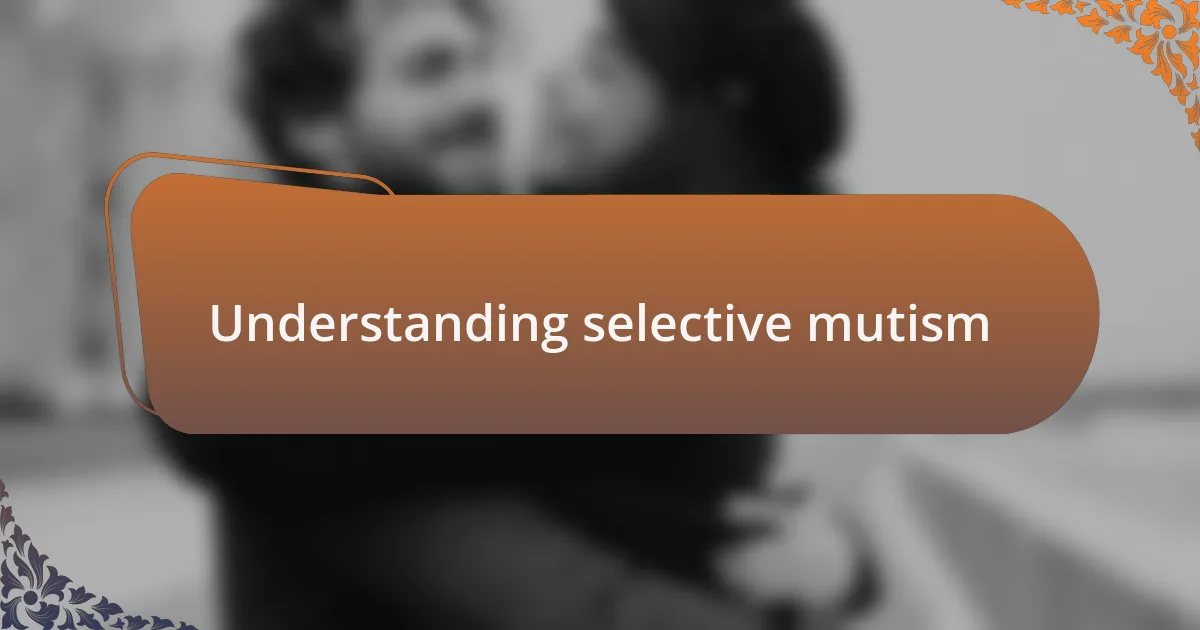
Understanding selective mutism
Selective mutism is a complex childhood anxiety disorder where a child feels unable to speak in certain social situations, despite speaking normally in other settings, like at home. I remember a moment where a child I worked with suddenly clammed up in a class discussion, leaving me wondering what triggered that silent barrier. It’s heartbreaking to witness someone’s struggle to express themselves, especially when you know they have so much to say.
Imagine standing in a room full of people, wanting to join in but feeling as if your voice has vanished. For many kids with selective mutism, that fear can be paralyzing. I’ve seen firsthand how this silence can mask vibrant personalities waiting to be uncovered. It makes me think—what prevents them from speaking in those moments? Is it the fear of judgment, or is it simply overwhelming anxiety?
The condition often stems from a blend of environmental factors and innate temperament, creating a perfect storm for communication breakdowns. In my experience, fostering an accepting environment makes a world of difference. Have you ever considered how supportive relationships can dissolve barriers? Sometimes, just knowing someone believes in you can coax the words out from the depths of silence.
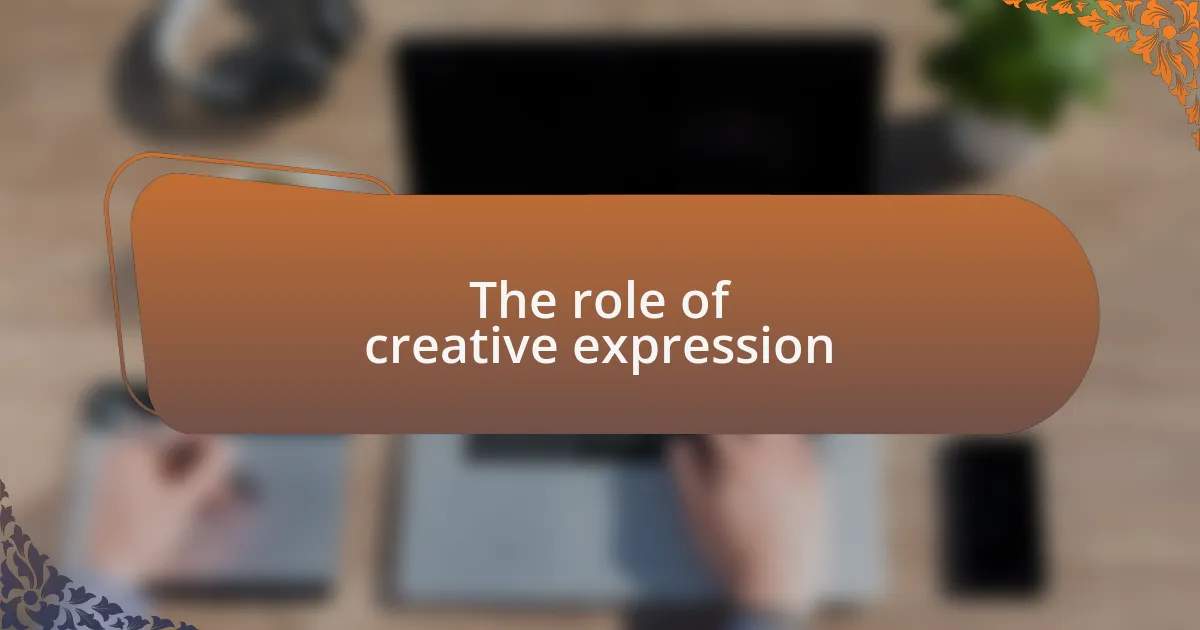
The role of creative expression
Creative expression plays a crucial role in allowing children with selective mutism to communicate in ways that words often cannot. I recall a workshop where a timid girl picked up a paintbrush and suddenly transformed. Through her art, she expressed emotions that she struggled to verbalize, revealing a vibrant world within her that was simply waiting for an outlet. Have you ever watched someone find their voice through creativity? It’s a powerful reminder that expression comes in many forms.
Art, music, and movement can provide a safe space for self-exploration, often bridging the gap left by verbal communication. During a summer camp, I witnessed a boy who rarely spoke start to hum along to a song, his joy radiating through the air. Those moments were profound; it demonstrated that sometimes, the heart speaks louder than words. Doesn’t it make you wonder how creativity can unlock pathways to connection that we often overlook?
In my experience, encouraging children to engage with creative outlets can be transformative. I had the opportunity to lead drama sessions where young ones would enact stories through role play. Watching them embrace different characters seemed to peel away the layers of anxiety, showcasing a natural ability to express thoughts and feelings. Isn’t it remarkable how creativity can create safe spaces for dialogue, opening up new avenues for communication?
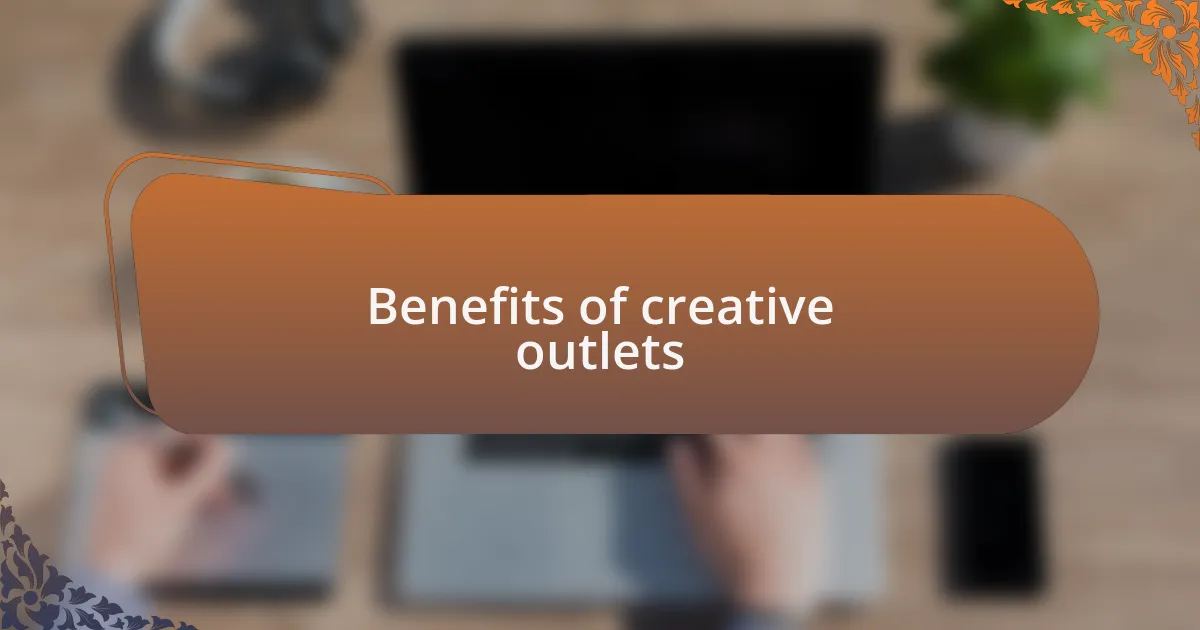
Benefits of creative outlets
Creative outlets offer a unique sanctuary for children with selective mutism, allowing them to explore their emotions freely. I remember a young girl who found solace in sculpting. As her hands crafted shapes from clay, her focus shifted, and with it, her confidence grew. Isn’t it fascinating how the physical act of creating can draw out feelings that are often trapped inside?
Engaging in artistic activities can significantly reduce anxiety and boost self-esteem. I recall a boy in my art class hesitantly participating at first. Over time, he began to create beautiful collages that displayed his inner thoughts. Observing his transformation made me realize how creative expression can serve as a gentle nudge towards self-acceptance. Don’t you find it incredible how the act of creating can not only comfort but also empower?
Moreover, creative outlets foster connections with peers, a crucial aspect for children facing social challenges. In a group music session, I saw previously anxious children coming together, laughing, and sharing rhythms. Their united response to music illustrated how creativity can break down barriers and foster community. Have you ever experienced that special bond formed through shared artistic endeavors? It’s a reminder of the inherent power of creativity to cultivate relationships and support.
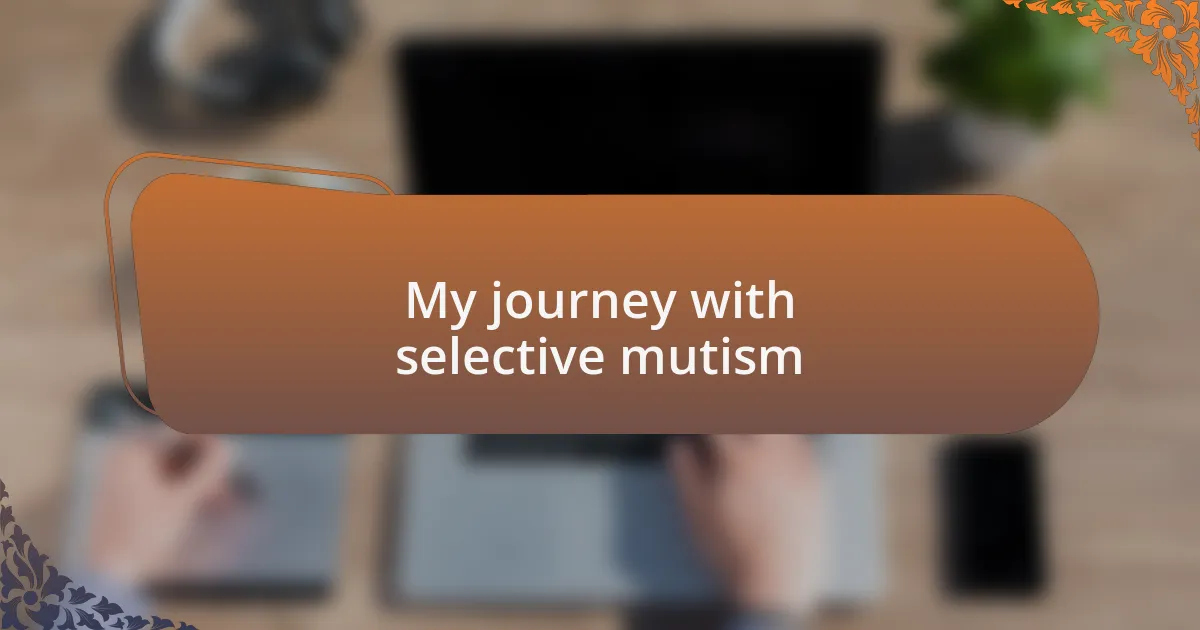
My journey with selective mutism
My journey with selective mutism has been a complex interplay of silence and expression. Growing up, I often felt like my voice was trapped, locked away by my anxiety. I vividly recall one particular school presentation where even the thought of speaking made my heart race, yet the moment I put pencil to paper to illustrate my ideas, I found an unexpected clarity as if my internal dialogue was finally able to breathe.
There were times when I stumbled upon creative outlets that allowed me to communicate without the fear of judgment. I remember getting lost in writing short stories, where I could unleash emotions and experiences that felt too daunting to share verbally. Writing became my voice, and each tale I crafted was a step toward being heard. Have you ever found a form of expression that seemed to effortlessly echo your thoughts?
As I navigated through the challenges of selective mutism, sharing my artwork with others became a pivotal moment in my journey. When a friend praised my painting, a warm rush of affirmation washed over me, making me realize that expression could inspire connection. Those moments taught me that sometimes, art speaks louder than words, creating a bridge between silence and understanding. Doesn’t it feel powerful when someone sees you through the lens of your creativity?
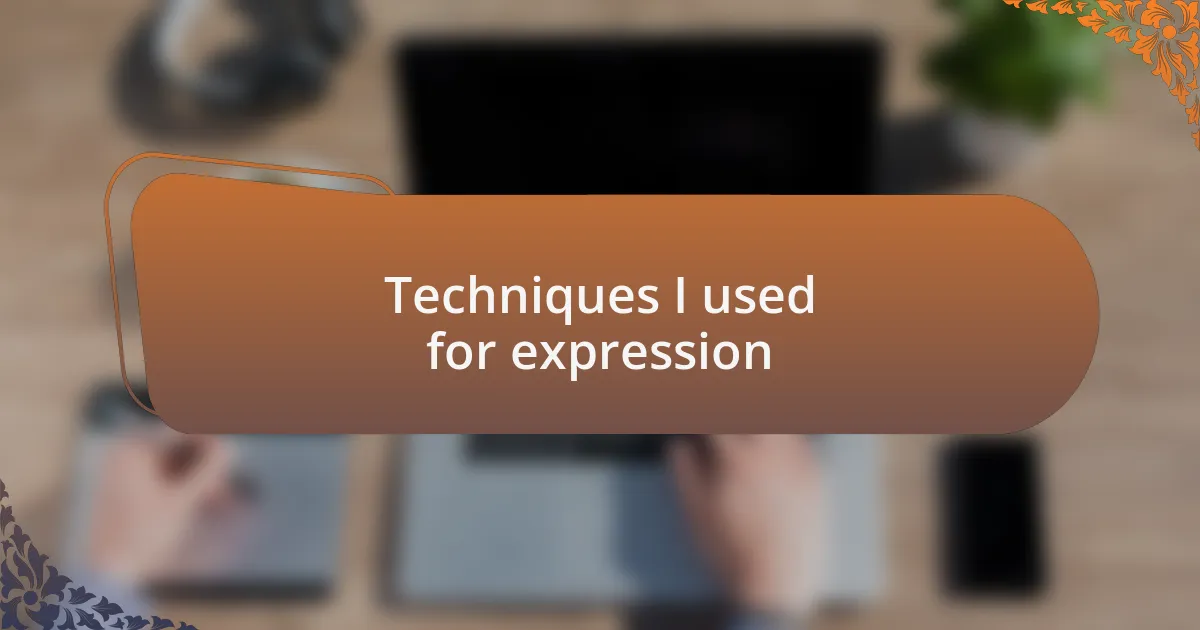
Techniques I used for expression
Engaging in music was one of the most liberating techniques I discovered for expression. I recall sitting at the piano for hours, letting my fingers dance over the keys, producing melodies that resonated with my feelings. The songs I played became an outlet, where my silent struggles transformed into beautiful notes that spoke volumes without uttering a single word. Have you ever lost yourself in a piece of music that perfectly mirrored your emotions?
I also turned to journaling as a therapeutic outlet. The simple act of putting pen to paper allowed me to articulate thoughts that felt too heavy to voice. I remember days when the page was my confidant, soaking up my fears, dreams, and frustrations. If only those pages could talk back, right? They captured my truth without judgment, providing a safe space to explore the depths of my experiences and emotions.
Moreover, finding solace in dance opened up a whole new realm of expression. I would often catch myself moving to the rhythm in my living room, feeling free from the constraints of spoken words. Each movement acted as a form of communication, translating my inner turmoil into graceful gestures. Doesn’t it feel liberating when your body becomes a language all its own, telling stories that words sometimes can’t convey?
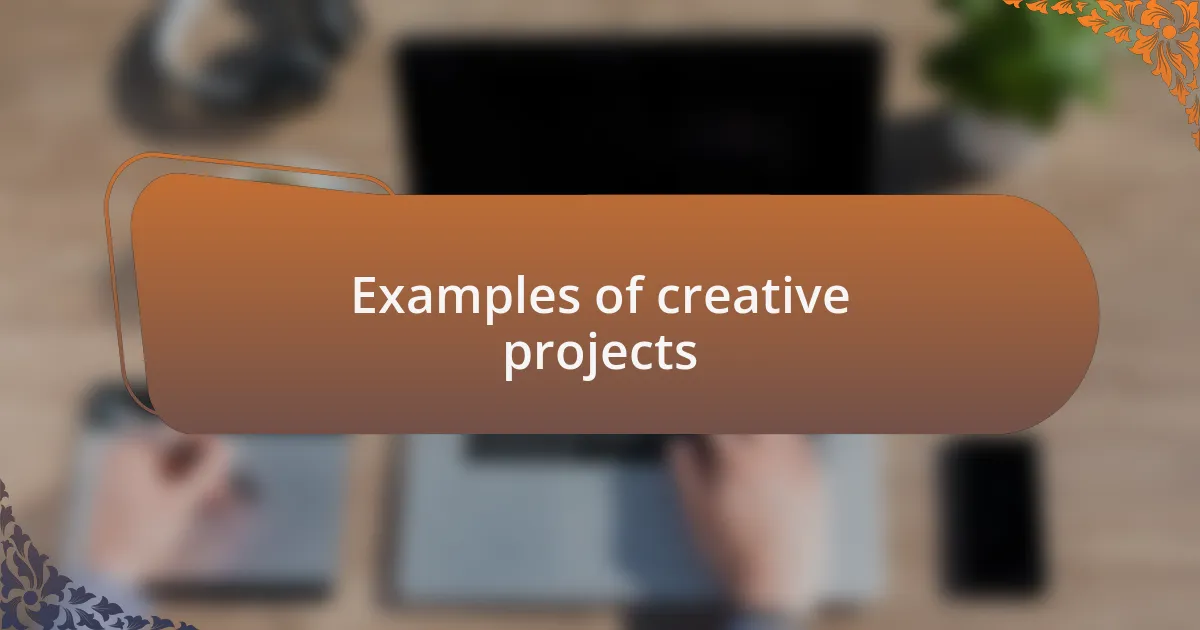
Examples of creative projects
Creative expression can take many forms, and one of the projects that deeply resonated with me was visual art. I started painting as a way to channel my feelings onto canvas. One evening, while grappling with a whirlwind of emotions, I stood before a blank canvas and poured my heart into vibrant colors and sweeping strokes. As the image transformed before me, I felt a sense of release, almost as if every brushstroke whispered the words I couldn’t find.
Another project that stood out was writing poetry. With each poem, I aimed to capture fleeting moments—joy, sadness, and everything in between. One particular piece I penned during a quiet summer afternoon allowed me to express a yearning for connection that lingered in my heart. Crafting those lines became not just a means of communication, but a way to navigate and validate my experiences. Have you ever felt that your thoughts deserve to be painted in verse?
I also engaged in creating short films, blending storytelling and visual art. One film captured my journey through selective mutism, using imagery and sound to articulate what remained unspoken. The challenge was both exhilarating and humbling, as I sought to convey emotions through scenes rather than dialogue. This process opened my eyes to the power of non-verbal communication. Doesn’t it amaze you how a single image can tell a story louder than words ever could?

Tips for others to start
When embarking on your creative journey, I suggest starting simple. Reflect on what resonates most with you—whether it’s doodling in a sketchbook or jotting down random thoughts in a journal. I remember my first attempts were often rough and unrefined, but that didn’t matter; what counted was that I was expressing myself. Have you ever allowed yourself to create without judgment?
Consider connecting with others who share similar experiences. I found that joining a community around creative expression was pivotal. When I shared my artwork at a local exhibit, I was surprised to see how many people related to my story. It was a moment of revelation that left me wondering—how many others out there are itching to unleash their creativity but are held back by fear?
Try exploring different mediums until something truly speaks to you. I experimented with everything from sculpture to digital art, each time discovering new parts of myself. One afternoon, I stumbled upon a photography project that opened my eyes to the beauty surrounding me and helped me appreciate the small moments often overlooked. What if one new medium could shift your perspective completely?